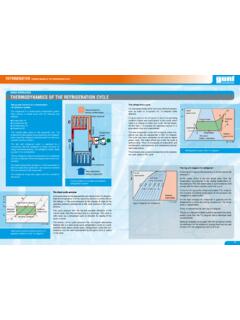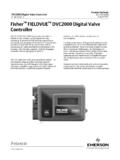Transcription of gunt
1 Mechanical testing methods317316 Materials testingIntroductiongunt6 Materials testing studies the behaviour of materials under dif-ferent loads. In particular, the relationship between the acting forces and the resulting deformation and the limit stresses that lead to failure of components are characteristic values obtained from the testing process are used for materials development, designing components and in quality assurance. There is a range of standardised testing methods to characterise the mechanical properties of materials as precisely as possible:Tensile test to determine the tensile strength and elongation at fractureThe tensile test is the most important testing method in destructive materials testing.
2 A standardised specimen with a known cross section is loaded uniformly with relatively low increasing force in the longitudinal direction. A uniaxial stress state prevails in the specimen until contraction commences. The ratio of stress to strain can be shown from the plotted load-extension propertyTesting methodElasticity, plasticityTensile test, compression test, bending test, torsion testStiffness, material behaviour under static loadCreep behaviourCreep rupture testHardnessBrinell, Rockwell, VickersToughnessImpact testFatigue behaviour, fatigue strengthW hler fatigue testFracture type Fracture mechanism StressForced fracture occurs abruptly matte or glossy crystalline and partially fi ssured surface over the entire cross section.
3 In ductile fractures, shear lips often occur at the edgeStatic overstressa) low-deformation cleavage fracture occurs when the largest direct stress exceeds the cleavage fracture stress b) ductile fracture (microscopic honey-comb fracture) occurs when the largest shear stress exceeds the yield stressc) a low-deformation intergranular frac-ture can occur with a reduction of the grain boundary cohesion under the infl uence of direct stressTensile test, impact testFatigue fracture can develop following repeated stress under the infl uence of shear or direct stress low-deformation fractureDynamic overstressStarting from notches or imperfections, oscillatory cracks propagate through the material.
4 When the material strength is exceeded, the remaining surface fractures by way of a forced hler fatigue testCreep fracture continuous time-dependent process sets in at higher temperatures and eventually leads to fracture, although the material is loaded below the hot yield point pores on grain boundaries lead to material damageStatic stress, increased temperature Countless cracks form independently of each otherCreep rupture testThe fracture behaviour is used to characterise the material. The summary below shows a relationship between failure mechanism and stress:Selection of specimen forms for tensile tests according to DIN 50125 Honeycomb fracture Fatigue fracture Cleavage fracture {!}
5 (2 {!(1 {!(5 The stress-strain diagram shows clearly the different behaviour of the individual materials and provides the characteristic values for tensile strength Rm, yield strength Re, proportional limit Rp, elongation at fracture A and the elastic modulus material has a characteristic profi le of stress and strain. hardened steel: very high tensile strength tempered steel: high tensile strength low-strength steel: very high elongation, low tensile strength aluminium alloy: low elastic modulus {!(a {!(b {!(cTest process of a classic tensile test F force, a low-deformation fracture, b ductile fracture, c completely ductile fractureStress-strain diagramFRmReRp AE = {!))))))}}}}}}
6 (4 {!(3 stress, strain, Rp proportional limit, Re yield strength, Rm tensile strength, A elongation at fracture 1 Hooke s straight line, 2 L ders strain, 3 strain hardening region, 4 start of contraction, 5 fractureMechanical testing methods319318 Materials testingIntroductiongunt6 Compression test to determine fl ow curvesVarious methods for determining hardnessTest process in the compression test1 thrust plate, 2 specimen, 3 pressure plate, F test loadStress-compression diagram stress, compression, s 0,2% offset yield point, y compression yield stress, F compression strength, 1 elastic region, 2 fractureEvery material has a characteristic profi le of compression and stress.))}
7 Brittle plastic, no compression strength ductile plastic with compression yield stress ductile plastic without compression yield stress ductile plastic without fractureCompression tests are less signifi cant for testing metallic materials compared to tensile tests. However, when study-ing building materials such as natural stone, brick, concrete, wood etc., the compression test is fundamentally import-ant. A standardised specimen with a known cross section is loaded uniformly with low increasing force in the longitudinal direction. A uniaxial stress state prevails in the specimen. The ratio of stress to compression can be shown from the plotted force-path diagram.
8 The stress-compression dia-gram shows clearly the different behaviour of the various separate materials and provides the characteristic values for compression strength, 0,2% offset yield point and the compression yield refers to the mechanical resistance with which a body opposes the intrusion of another body..Principle of the Rockwell hardness testRockwell's hardness test method allows the hardness to be read directly on a dial gauge as the difference of the depths of penetration. Test process and optical measurement of the permanent indentation 1 pyramid-shaped diamond, 2 specimen, F test load, d1 and d2 diagonalsTest process and measurement of the depth of penetration 1 diamond cone, 2 specimen, I test pre-load F0 is applied to the test body and the dial gauge is set to zero, II additional test load F1 is applied for a given duration, III additional test load F1 is removed, a depth of penetration due to test pre-load F0, b depth of penetration due to additional test load F1, c elastic recovery after removal of the additional test load F1.
9 D lasting depth of penetration hHB Brinell hardness value, F test load in N, AB impression surface in mm2, g= 9,81 gravitational acceleration {!(1 {!(2 {!(3 FStress-compression diagram {!(1 {!(2s = 0,2% 0,2 y F 90 90 {!(1d1d2 {!(2F {!(1d1d2 {!(2 FTest process and optical measurement of the permanent indentation1 hard metallic sphere, 2 specimen, F test load, d1 and d2 diameters perpendic-ular to each otherHB =0,102 FABto convert N into kgf0,102 =119,81g=Principle of the Brinell hardness testIn this test method, a standardised test body a hard metal sphere is pressed into the workpiece under defi ned conditions. The surface of the lasting impression is then measured optically.)))))))))}}}}}}}}}
10 The impression surface is calculated from the impression diameter and the sphere diameter. A triaxial stress state develops in the specimen, underneath the impressing test Brinell hardness is calculated from the test load and impression surface of the spherical of the Vickers hardness testThe test method is similar to the Brinell hardness test. Unlike the Brinell method, a pyramid-shaped diamond is used as the test body. The impression diagonal is determined by measuring the two diagonals d1 and d2 and by taking the average. The Vickers hardness is the quotient of the test load and impression surface. {!(1adb {!(2F0F0F0+F1 IIIIIIcMechanical testing methods321320 Materials testingIntroductiongunt6 Bending tests for the study of deformation behaviourThe most frequently studied bending load in materials testing is the three-point bending test.))}}









